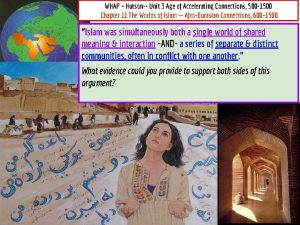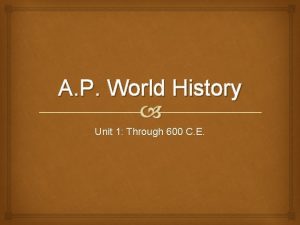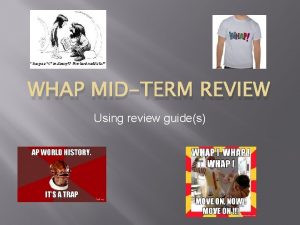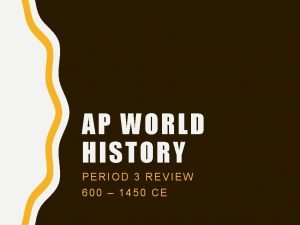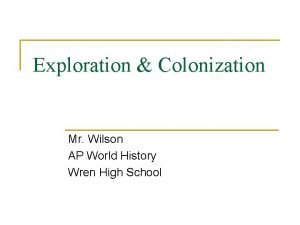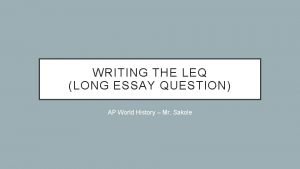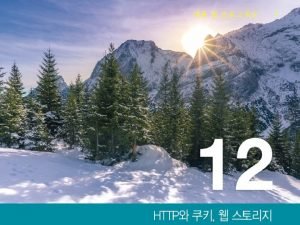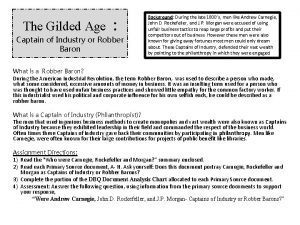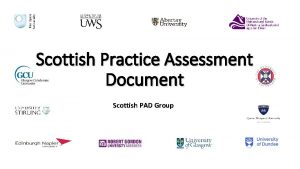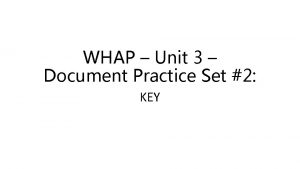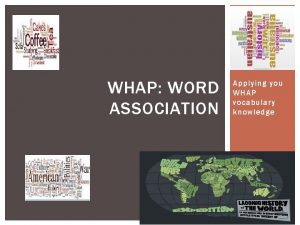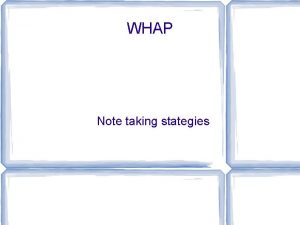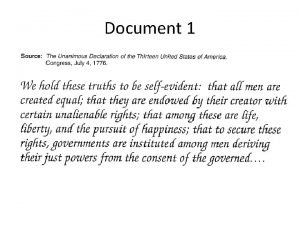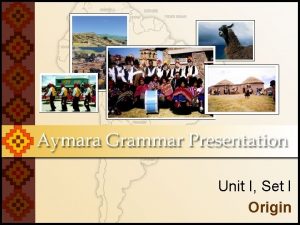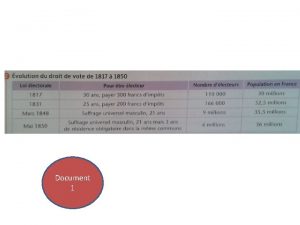WHAP Unit 3 Document Practice Set 2 WHAP















- Slides: 15

WHAP – Unit 3 – Document Practice Set #2:

WHAP: Period 2, Unit 3: Land Based Empires (14501750) (2020 Review Documents for the week of April 20 th) DUE: Wednesday, April 22 nd • Directions: The following documents have been pulled from a variety of sources. Each document covers content included in Period 2 (unit 3). We will use the following to review content, in addition to the AP Online Review Classes that are hosted on the AP You. Tube Channel. • During our class on Weds 4/22, We’ll go over – as many documents as time allows and will then spend the rest of the class going over any other questions you have. • ** REVIEW YOUR UNIT 3 PACKET – THEMES – “Land-Based Empires” • Governance, Religious/Belief Systems, Art/Monumental Architecture, Tributary States, Use of Technology

For each document below you should complete the following: • In multiple sentences (3 minimum), describe the context of the document (CONTEXTUALIZATION) • Source each document using all four sourcing categories (POV/CAP) • • Point of View Purpose Audience Historical Context • Discuss / Develop one piece of evidence / historical event beyond the document that is relevant to the document (OUTSIDE INFO) • Use the Template below, for each of the Docs that follow:


Doc. 1 Illustration, Ottoman official and assistant registering Christian boys for the Devşirme. The official takes a tax to cover the boys' new clothes and the cost of transport, while the assistant records their village, district and province, parentage, date of birth. -- Ottoman miniature painting, 1558, Tokapi Palace, Istanbul, Turkey.

Doc 2 After a long period of warfare and chaos, the Tokugawa placed primacy on political order, social order, and order in international relations. Tokugawa political order was exercised through a system of "centralized feudalism. " Which means that you have feudal lords with their own domains and yet, there is a centralized state that is, that has the shogun at the head. The shogun is the defacto ruler of the country who rules at the order of the emperor, but in fact, rules the country. It is a hereditary, military rule so that Tokugawa shoguns ruled the country from 1600, or 1603, to 1868. Tokugawa Ieyasu was able to gain control of the entire country. Once a daimyo himself, now he became shogun, ruling over the roughly 250 other daimyo across Japan. Thus the Tokugawa house centralized a system that was still feudal in shape. A very important part of Tokugawa centralized feudalism was known as the "alternate attendance system" or sankin kôtai. It simply meant that every daimyo from every one of these two-hundred sixty odd domains had to live every other year in the capital city of Edo and to leave permanently his main life and his heir, that is the future daimyo, living permanently in the city. This had immense implications for the long course of Tokugawa history… Oxnam, Robert, Carol Gluck and Henry Smith, “ORDER IN TOKUGAWA JAPAN, Political Order: The Alternative Attendance System”, Asia for Educators: Asian Topics, Columbia University, Columbia. edu. , 2002

Doc 3 “Scene Of Human Sacrifice Before Aztec Emperor – Temple @ Tenochtitlan”. Miniature From Aztec Codex Azcatitlan, 16 th Century. Granger Collection.

Doc 4 The “Sun King”, Louis XIV and his Descendants, in the Versailles Palace, 1710, Nicolas de Largillière - artist

Doc 5 “Howbeit there is a most stately temple to be seen, the walls whereof are made of stone and lime; and a princely palace also built by most excellent workemen of Granada. Here are many shops of artificers, and merchants, and especially of such as weave linen and cotton cloth. And hither do the Barbarie merchants bring cloth of Europe. All the women of the region except maidservants go with their faces covered, and sell all necessarie victuals. The inhabitants, & especially strangers there residing, are exceeding rich, insomuch that the king that now is, married both his daughters vnto two rich merchants. Here are many wells, containing most sweet water; and so often as the riuer Niger overfloweth, they conueigh the ater thereof by certain sluces into the towne. Corne (sorghun), cattle, milke, and butter this region yeeldeth in great abundance: but salk it verie scarce heere; for it is brought hither by land from Tagaza, which is five hundred miles distant. When I myselfe was here, I saw one camel load of salt sold for 80 ducates. The rich king of Tombuto (Timbuktu) hath many plates and scepters of gold, some of ehreof weigh 1300 poindes; … He hath alwayes three thousand horsemen, and a great number of footmen that shoot poysoned arrows, attending upon him. …Here are great store of doctors, judges, priests and other learned men, that are bountifully maintained at the kings cost and charges. And hither are brought divers manuscripts or written bookes out of Barbarie, which are sold for more money than any other merchandize…” Leo Africanus, an Arab Berber traveler visited Timbuktu in the Kingdom of Songhay early in the 1500 s and left this description of trade, life and the influence of Islam in that city. Africanus, Leo. Descrittione dell'Africa (Description of Africa), 1550.

Doc 6 The Taj Mahal, Agra – India, built 1632 -1653, by Shah Jihan

Doc 7 The early Ming dynasty attempted to use paper currency, with outflows of bullion limited by its ban on private foreign commerce. Like its forebears, paper currency experienced massive counterfeiting and hyperinflation in 1425, under the Hongwu Emperor. The notes remained in circulation as late as 1573, but their printing ceased in 1450. Minor coins were minted in base metals, but trade mostly occurred using silver ingots. As their purity and exact weight varied, they were treated as bullion and measured in tael. These privately made “sycee” first came into around 1423, the year sycee became acceptable for payment of tax obligations. In the mid-15 th century, the paucity of circulating silver caused a monetary contraction and an extensive reversion to barter. The problem was met through smuggled, then legal, importation of Japanese silver, mostly through the Portuguese and Dutch, and Spanish silver from Potosí carried on the Manila galleons. Silver was required to pay provincial taxes in 1465, the salt tax in 1475, and corvée exemptions in 1485. By the late Ming, the amount of silver being used was extraordinary, the Zheng clan of merchants regularly engaged in transactions valued at millions of taels. However, a second silver contraction occurred in the mid-17 th century when King Philip IV of Spain began enforcing laws limiting direct trade between Spanish South America and China at about the same time the new Tokugawa Shogunate in Japan restricted most of its foreign exports, cutting off Dutch and Portuguese access to its silver. The dramatic spike in silver’s value in China made payment of taxes nearly impossible for most provinces. The government even resumed use of paper currency amid Li Zicheng’s rebellion. During the Ming Dynasty currency and taxation policies shifted. Source: “The Economy Under the Ming Dynasty”, Boundless World History, courses. lumenlearning. com

Doc 8 Abstract: “Tax-farming as practiced in Medieval Egypt, Moghul India and the Ottoman empire is considered as a means of resource allocation in an interest-free economy. Material from Turkish archives is utilized to analyze how the system worked by giving signals to the state, in the form of the bids made by the tax-farmers, as to the relative profitability of the various sectors of the economy. In making these bids, the tax-farmers were guided by the expected rates of return in the relevant sectors. Changing profit expectations caused geographical and sectoral shifts of resources. The paper places the historical discussion into perspective by making a brief review of contemporary literature on resource allocation in a modern interest-free Islamic economy. It also notes some negative aspects of the practice of tax-farming. ” Çizakça, Murat, “Tax-Farming and Resource Allocation in Past Islamic Societies”. Journal of King Abdulaziz University: Islamic Economics, Vol. 1, No. 1, 1989. https: //ssrn. com/abstract=3076104

Doc 9 A Fresco painting from the Chehel Sotun Pavillion in Isfahan, Iran, depicting Persian Safavid dynasty (Shia) period warfare against the Ottomans (Sunnis). Ottoman – Safavid War: 1532 -1555 – artist unknown Doc 9 B “Gunpowder Empires, and the Sunni – Shia Divide”, Dhaka Tribune, dhakatribune. com, 2015

Doc 10 Surviving original copy of Martin Luther’s 95 Theses; printed 1517 – Nuremberg, Germany, by Hiernoymus Höltzel

Doc 11 Janam-Sakhi, “Birth-Testimonies” – the 3 rd oldest known – written collection of the anecdotes of Gurū Nānak (1469– 1539), - originally transmitted orally among the faithful. Manuscript, 1733 – artist, Ālam(u)cand Rāj. British Museum Collection.
 Whap unit 1
Whap unit 1 Whap unit 1
Whap unit 1 Total set awareness set consideration set
Total set awareness set consideration set Training set validation set test set
Training set validation set test set Whap midterm review
Whap midterm review Ap world history 600 to 1450 review
Ap world history 600 to 1450 review Castas indianas
Castas indianas How to write an leq for ap world history
How to write an leq for ap world history Javascript:document.write(document.cookie)
Javascript:document.write(document.cookie) How to connect elmo to laptop
How to connect elmo to laptop Captains of industry gilded age
Captains of industry gilded age Sceprn
Sceprn Unit 10, unit 10 review tests, unit 10 general test
Unit 10, unit 10 review tests, unit 10 general test Bounded set vs centered set
Bounded set vs centered set Fucntions
Fucntions Crisp set vs fuzzy set
Crisp set vs fuzzy set
